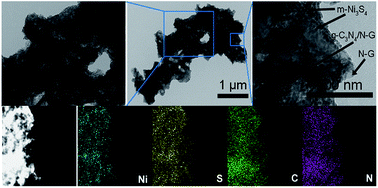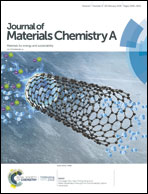The controlled construction of a ternary hybrid of monodisperse Ni3S4 nanorods/graphitic C3N4 nanosheets/nitrogen-doped graphene in van der Waals heterojunctions as a highly efficient electrocatalyst for overall water splitting and a promising anode material for sodium-ion batteries†
Abstract
As a kind of novel multi-functional nanocomposite, a ternary hybrid of monodisperse Ni3S4 nanorods/graphitic C3N4 nanosheets/nitrogen-doped graphene with heterostructured architecture is controllably constructed for the first time, illustrating great potential for overall water splitting and the fabrication of sodium-ion batteries. Intensive investigations revealed that the ternary hybrid with robust and intertwined nanostructures possesses shorter diffusion pathways, smaller diffusion resistance and faster transfer speeds of electrons and ions, which could expedite the transport of electrolyte to flood and interact with reaction sites, dynamically and thermodynamically. Notably, the active Ni3S4 nanorods within the unique integrated ternary hybrid embedded in graphitic C3N4 nanosheets over a conducting substrate of nitrogen-doped graphene could strongly avoid agglomeration, abscission, anisotropic volume expansion and irreversible mechanical failure, even during extreme electrochemical reactions. Owing to the integrated effect, the ternary hybrid delivers excellent electrochemical performance with long-term stability during water splitting and cycling durability when used in sodium-ion batteries. In particular, a low onset potential of 40 mV (vs. RHE, J = −1.5 mA cm−2) is observed in the HER process, and the applied potentials are also as small as 1.47 V (vs. RHE) and 1.51 V for the OER and overall water splitting, respectively, at 10 mA cm−2 under the same alkaline conditions. As for sodium-ion batteries, the ternary hybrid possesses an advanced specific capacity of ∼670 mA h g−1 at 100 mA g−1 with particularly excellent rate capabilities and it could even work at a high current density.



 Please wait while we load your content...
Please wait while we load your content...